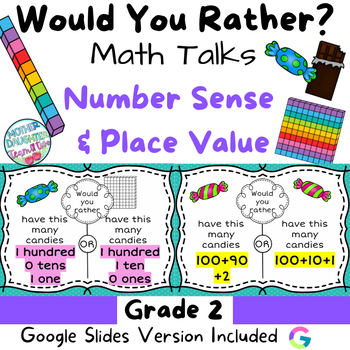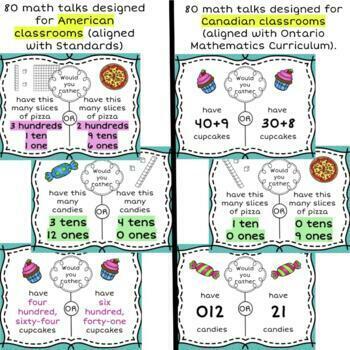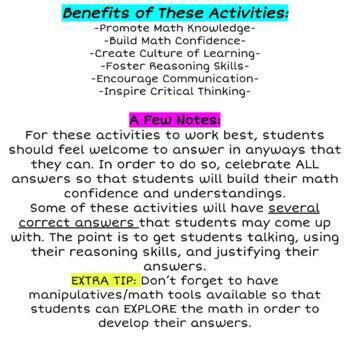Would You Rather - Grade 2 - Number Sense & Place Value MATH Talks & Centers
- Zip
What educators are saying
Also included in
- *** Now includes digital Google Slides & PDF Versions****7 Products Included*PERFECT FOR AMERICAN AND CANADIAN CLASSROOMS. This is a YEAR-LONG resource! Keep your kiddos busy ALL YEAR with engaging math talks!Your students will LOVE sharing their ideas and justifying their answers with these engPrice $16.50Original Price $23.75Save $7.25
Description
***** NOW INCLUDES GOOGLE SLIDES FORMAT as well as PDF*****
No prep!! Great for in person learning and digital classes!
*American and Canadian versions included*
Your students will LOVE sharing their ideas and justifying their answers with these engaging math talks! You will love how differentiated these activities are. You will find several math talks that gradually move through grade 1, 2, and 3 so that you can select the best suitable activities to meet your students needs. Additionally, you can use these math talks to build students' number sense and place value understandings gradually over the whole school year.
Get your students talking about math! Pose the "Would You Rather" questions to your students in order to:
-Promote Math Knowledge-
-Build Math Confidence-
-Create Culture of Learning-
-Foster Reasoning Skills-
-Encourage Communication-
-Inspire Critical Thinking-
What's Included:
80 activities in for American classrooms and 80 suitable for Canadian classrooms provided in two formats large group format (for math talks) and individual use format (for math centers). These activities are in the areas of number sense, place value (hundreds, tens, ones,) and include expanded form and written form. The American activities are directly aligned to the Common Core Educational Standards and are aligned to grade 1, 2, and 3 standards to meet the needs of your students. The Canadian activities were designed using the Ontario Mathematics Curriculum starting with grade 1 and moving through grade 3 so that you can differentiate for your students.
How to use this product:
These Would You Rather activities are provided in two formats for your convenience. First you will find a large scale format for group discussions. Second, you will find a format that includes space for students to write their responses which are best used for individual use or math centers.
Large Group Format (NOW IN PDF AND GOOGLE SLIDES):
- Simply post these WYR images digitally using your projector/smartboard, or print the page and post it on your board.
- Read the question aloud for students “would you rather ___ or ___?” and give students time to process and think of responses. Next, have students respond with their thinking and celebrate their connections!
- Remind students to listen to others and respect their peers’ responses. Some students might have differing opinions and that’s ok!
Individual/Math Center Format:
- Provide the individual use format WYR activities to students to complete as a math center. This works best when a group of students are at the center at the same time so that they can discuss and learn from one another.
- This works best when there are related manipulatives/math tools available for students so that they can move through the CRA model (concrete, representational, abstract).
How to differentiate with this product:
This product is easily differentiated for your convenience! These math activities start with the basic and fundamental concepts of math and become slightly more challenging as the activities progress. If your students are struggling with a concept I suggest you select the first activities within that area of math, or if your students are advanced, challenge them by skipping ahead.
Large Group Format:
- The large group format of this product can be differentiated further if you have small-group discussions with students that are of like-ability. By facilitating the discussions you can ensure that the students are noticing and discussing the important concepts. This is also a great practice because it will maintain the math confidence of your struggling students. Students will be able to contribute to the best of their abilities while not having to worry that students of other levels will take over the discussion.
Individual/Math Center Format:
- The individual/math center format of this product can be differentiated so that your non-writers can still participate. Students have the space to write or draw their answers and there are two different writing formats, one for your emerging writers with double-lines for printing, the other has regular lines for your proficient writers.
- You can further differentiate math centers by grouping your non-writers with responsible and caring peers who will write responses that all group members contribute.
- Another great way to differentiate this product, which students LOVE, is by having them respond verbally using a recording device. This is great for non-writers, students who require more processing time before responding, and students who are anxious to talk in front of their peers. The very best way to do this is by using the FlipGrid app/website. Students LOVE it and can easily record their voices, as well as visuals, to respond to the “would you rather” prompt.
When to do math talks:
Math talks are amazing for introducing concepts and consolidating knowledge.
- You can use these activities to introduce math topics to students to gain an understanding of their prior knowledge. If you notice that your students have very little knowledge of a concept you can use the activity to introduce related vocabulary, strategies, and facts by expanding on student ideas and modelling. This will give students a foundation for their learning as they move through a unit.
- You can also use these activities to consolidate knowledge. At the end of a lesson, weeks of lessons, or unit, you can use a math talk which will give students an opportunity to showcase what they have learned. Additionally, this will allow you to informally asses the connections that students make.
- Got an extra 10 minutes in your day?? Throw up a math talk! You don’t necessarily need to search for one that is directly related to the math concepts you are currently teaching, instead you can use these activities to ensure students don’t forget information that they previously worked on. For example, if your students worked on addition and subtraction at the beginning of the school year, you could do related math talks occasionally ALL YEAR to ensure they maintain the big ideas from the math concept. (This is especially effective if you are teaching a grade that is tested at the end of the year).






